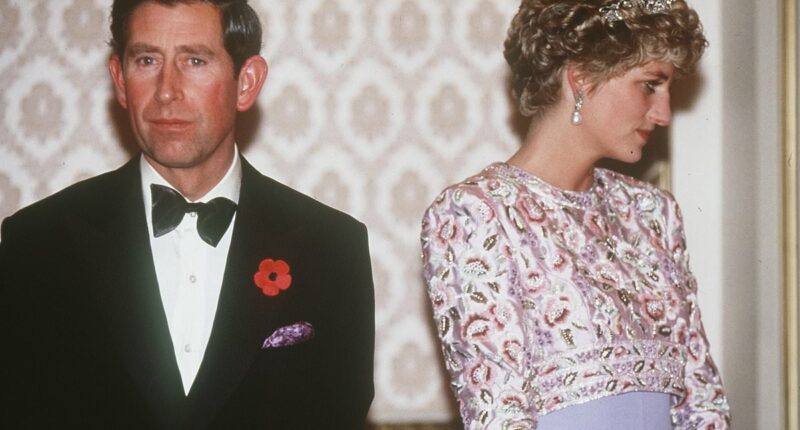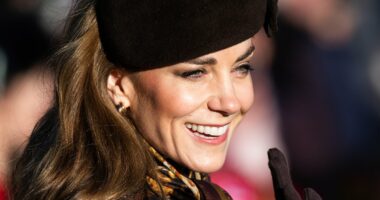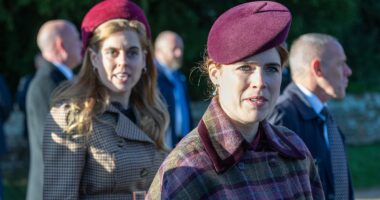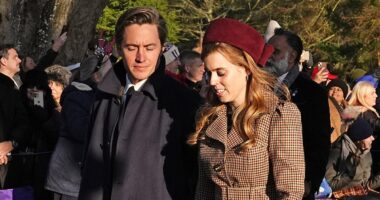Share this @internewscast.com
In July 1981, Prince Charles and Lady Diana Spencer exchanged vows at the iconic St. Paul’s Cathedral, creating what many hailed as the royal union of the century.
This historic ceremony was particularly remarkable as it was the first time in 300 years that a British citizen wed the heir to the throne. The event captivated a global audience, with an unprecedented 750 million people from 74 countries tuning in to witness the illustrious occasion.
However, just 11 years later, the enchantment of their marriage seemed to have waned. Speculation about possible marital discord between the Prince and Princess of Wales began to circulate widely.
In an effort to quell these rumors, it was announced in November 1992 that Charles and Diana would embark on a four-day visit to South Korea, aptly named the ‘Togetherness Tour’.
The trip aimed to demonstrate to the public that the couple, who were now parents to young Princes William and Harry, remained united and that talk of a separation was unfounded.
Despite these intentions, maintaining the appearance of marital bliss proved difficult. Video footage from the tour revealed visible tension and unhappiness, leading the media to dub the couple ‘The Glums’ due to their somber expressions.
Behind the scenes of the glitz and glamour presented during the engagements was a Royal couple in turmoil.
Royal biographer Andrew Morton, writing in Diana, Her True Story – In Her Own Words, explained that by the time the tour was set to begin, ‘the separation negotiations had reached a critical stage and the Princess was in no mood to continue the hollow charade’.

In November 1992, it was announced that Prince Charles and Princess Diana would be embarking on a four-day trip to South Korea, dubbed the ‘Togetherness Tour’. But the pair’s visible sorrow led to them gaining the nickname ‘The Glums’

Royal biographer Andrew Morton, writing in Diana, Her True Story – In Her Own Words, explained that by the time the tour was set to begin, ‘the separation negotiations had reached a critical stage and the Princess was in no mood to continue the hollow charade’

Following a fairytale wedding at St Paul’s Cathedral in July 1981, Prince Charles and his new Princess, Lady Diana Spencer, were hailed as the Royal couple of the century. But by November 1992, the magic had well and truly faded
He even likened Diana’s downcast mood to the couple’s notorious trip to India earlier that year.
During the heartbreaking trip in February 1992, the late Princess had been pictured sat alone on a bench outside of the Taj Mahal, meant to be a symbol of eternal love, while her husband attended a business meeting.
The memorable image of Diana looking forlorn was transmitted around the globe, relaying both a distinctive and distressing message that said ‘I am alone and I am unloved’.
Describing the acute resemblances between the two trips, Morton wrote: ‘She used the same tactics in Korea, determined to show the world what was really going on, a decision which several friends, including Rosa Monckton, then the President of Tiffany’s, questioned.’
Yet while the Princess’ bleak facial expressions made it seemingly undeniable that she was dispirited with the state of her marriage, in some ways it was a miracle that she had even boarded the flight to Seoul in the first place.
As Jonathan Dimbleby, writing in The Prince of Wales: A Biography, revealed, in August, the Duchess had ‘unexpectedly announced that she was not prepared to go’ on the all-important Seoul tour.
Indeed, the Princess’ refusal to attend the trip is perhaps slightly attributed to the explosive fallout and devastating repercussions of Morton’s book, Diana: Her True Story, which laid bare the heartbreaking reality of her experience in the Firm.
And so, as the Prince’s ‘staff contemplated the nightmarish task of explaining to the Korean authorities that the Princess would not after all be accompanying her husband on the first Royal visit to their country’, there was to be one last resort: enlisting the help of the Monarch.

Morton likened Diana’s downcast mood in Seoul to the couple’s notorious trip to India earlier that year. The late Princess had been pictured sat alone on a bench outside of the Taj Mahal, meant to be a symbol of eternal love, while her husband attended a business meeting

Describing the trip as a ‘dreadful experience’, Jonathan Dimbleby, writing in The Prince of Wales: A biography, recalled the heartbreaking moment the Royal couple could barely look at each other paid their respects to the military war memorial (pictured)
Despite Charles’ pleas, it was only the late Queen that was able to persuade the Princess to travel to Korea following a discussion which, Morton claimed, was synonymous with a ‘showdown’.
‘Finally, the Prince told her bluntly that she would have to come up with an explanation of her own for staying behind.
‘At this, the Princess finally relented, saying meekly that as the Queen had asked her to go she would after all accompany him’, said Dimbleby.
Yet while Diana agreed to take part in the so-called ‘Togetherness Tour’, she was no longer going to play the role of a perfectly polished Royal actress.
And rather than seeming unified, the pair could not have appeared more distant as their loveless marriage was broadcast painfully on the world’s stage.
Describing the trip as a ‘dreadful experience’, Dimbleby recalled the heartbreaking moment the Royal couple paid their respects to the military war memorial held in the national cemetery.
As the pair stood solemnly in painstaking silence, the world was quickly collating a narrative that they believed to be true, namely that ‘the marriage was a sham and the couple had come to loathe one another’s presence’.
Certainly from the media’s perspective, the couple’s trip to Korea signalled a clear end to the fairytale.

While Diana agreed to take part in the so-called ‘Togetherness Tour’, she was no longer going to play the role of a perfectly polished Royal actress. Former royal press secretary Dickie Arbiter previously said: ‘The Prince and the Princess were the epitome of Mr and Mrs Glum’

When the pair attended a South Korean State Banquet hosted by then-President Roh Tae-woo, Diana, who donned a Catherine Walker evening gown and the Spencer family’s heirloom tiara, struggled to hold a sincere smile
Meanwhile, those closest to the Prince and Princess were also in no doubt.
Former royal press secretary Dickie Arbiter, who worked closely with Charles and Diana around this time, previously told The Mail about his experience when he accompanied the pair on their Korea tour.
He said: ‘I had travelled to Seoul ahead of the couple to carry out my usual pre-visit recce, and was on hand at the airport the day of their arrival. As the door to the aircraft opened, I turned to the protection officer and said: ‘We’ve lost this one.’
‘The Prince and the Princess were the epitome of Mr and Mrs Glum — her expression pinched and pale, his rigid and morose. Their body language was so hostile it was as if they could have killed each other with a single glance.
‘The dark cloud hanging over them would remain throughout the tour.’
Mr Arbiter went on to recall how while the Wales’ team were desperately striving to paint an image of unity, one courtier quickly dispelled such aim following an interrogative question posed by a photographer.
When a reporter asked the tour’s private secretary if their marriage was ‘OK’, the private secretary replied: ‘All marriages have their problems’.
‘It was an attempt to deflect the question, but he pretty much gave credence to all the rumours that we had spent months trying to quash. If we hadn’t lost the tour upon arrival, we had undoubtedly lost it now’, Mr Arbiter added.
And, according to Royal photographer Mark Stewart, others closely working alongside the pair were beginning to draw similar conclusions, suspecting ‘they didn’t want to be there with each other’ and that ‘things were not right’.

According to Dimbleby, while there had been ‘many occasions in the past when the Princess had been in a state of anxiety before or after one of her invariably polished public performances’ in Korea she was either ‘unable or unwilling to hide her sorrow from the public’

According to Royal photographer Mark Stewart, others closely working alongside the pair were beginning to draw similar conclusions, suspecting ‘they didn’t want to be there with each other’ and that ‘things were not right’
The Princess’ feelings of acute ‘loneliness and misery’ were hardly concealed, with, on numerous occasions, the photographers capturing their true feelings towards each other as they routinely avoided eye contact.
Indeed, Dimbleby notes that while there had been ‘many occasions in the past when the Princess had been in a state of anxiety before or after one of her invariably polished public performances’ in Korea, she was either ‘unable or unwilling to hide her sorrow from the public’.
When the pair attended a South Korean State Banquet hosted by then-President Roh Tae-woo, Diana, who donned a Catherine Walker evening gown and the Spencer family’s heirloom tiara, struggled to hold a sincere smile.
As Diana and Charles arrived at the event greeted by flashing photographers and sounds of applause, the Princess of Wales was seen looking up to the ceiling of the grand hall with despair, while walking at a great distance from her husband.
Then, when perhaps she believed the attention had been diverted towards Charles at a later point in the evening, she was seen staring forlornly into the distance in another heartbreaking display of the Princess’ gloom.
Jayne Fincher, a photographer who had been present at the notorious engagement, previously told The Mail that while Diana had ‘looked lovely’, it was clear that her ‘makeup was patchy and her eyes were red-rimmed.’
She added: ‘You could tell she’d been crying her eyes out, she looked awful. My heart went out to her.’

Jayne Fincher, a photographer who had been present at the notorious engagement, previously told The Mail that while Diana had ‘looked lovely’, it was clear that her ‘makeup was patchy and her eyes were red-rimmed’

Just one month after the trip to Seoul, on November 2, Prime Minister John Major announced in the House of Commons that the Prince and Princess of Wales were to separate. The separation saw the myth of the ‘perfect’ Royal Family suffer a mortal blow
Then, as the the ill-fated trip drew to a close, Diana was described as being in a ‘state of desperation, overcome by nausea and tears’.
During a farewell ‘prize-giving’ service for their accompanying team, it was clear that the writing was on the wall for the impending end to Charles and Diana’s marriage.
Indeed, one of Diana’s aides was said to have concluded that based on her attitude in Korea, she clearly ‘could no longer endure her marriage and wanted to break free, whatever the consequences’.
Evidently, despite its goals, the ‘Togetherness Tour’ had, tragically, pushed the couple even further apart. After the pair went their separate ways at the end of the trip, Charles wrote to a friend about his feelings of despair.
‘The strain is immense’, he wrote, ‘and yet I want to do my duty in the way I’ve been trained. I don’t know what will happen from not on but I dread it’.
Just one month later, on November 2, Prime Minister John Major announced in the House of Commons that the Prince and Princess of Wales were to separate.
‘It is announced from Buckingham Palace that, with regret, the Prince and Princess of Wales have decided to separate.
‘Their Royal Highnesses have no plans to divorce and their constitutional positions are unaffected. This decision has been reached amicably, and they will both continue to participate fully in the upbringing of their children’, Mr Major said.
Diana’s personal fairytale that had captured the nation’s hearts had shattered before the world’s very eyes. The Royal bubble had well and truly burst.
Following a devastating fire at Windsor Castle just 18 days after the announcement, it was unsurprising that the late Queen would later describe the year as her ‘annus horriblis’.
In a speech delivered just four days after the fire to mark her 40 years on the throne, she said: ‘1992 is not a year on which I shall look back with undiluted pleasure.
‘In the words of one of my more sympathetic correspondents, it has turned out to be an annus horribilis.’
The separation saw the myth of the ‘perfect’ Royal Family, and indeed its supposedly model couple, suffer a mortal blow that would haunt the Firm for decades to come.









